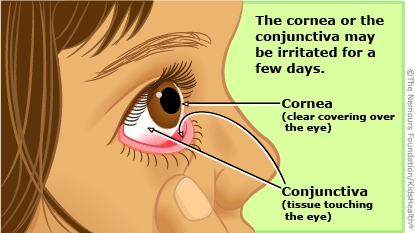How to Care for Your Child After the Removal of an Object From the Eye
Your health care provider removed an object from your child's eye (such as sand, dirt, or a small piece of plastic or metal). Your child may have some eye discomfort but should feel better and have full vision in a few days. Follow these directions as you care for your child.


-
Follow your health care provider's instructions for:
-
using any eye drops or ointment
-
whether it's OK to give medicine for pain such as acetaminophen (Tylenol® or a store brand) or ibuprofen (Advil®, Motrin®, or a store brand). Don't give ibuprofen to babies under 6 months old. Follow the package directions for how much to give and how often.
-
if your child wears contact lenses, when it's OK to wear them again
-
when to follow up to make sure the eye is healing well
-
Your child may have the feeling that something is in the eye, have slightly blurry vision, or be sensitive to light. Reassure them this is expected and will go away within a day. Don't let them rub or pull on the eye area.

Your child:
-
feels like something is in the eye, has blurry vision, or is sensitive to light for more than 24 hours after the procedure
-
doesn't feel back to normal after 72 hours
-
has a spot on the eye that wasn't there before

Your child has:

How are objects removed from the eyes? Health care providers first try to irrigate the eye (flush it with water) so that the object washes out. If that doesn't work, they can try a moist cotton swab or use a tiny instrument to take it out.
Why are my child's eyes yellow or orange? To numb the eye and see the object, a harmless dye (fluorescein) is often used. It makes the tears, whites of the eye, nasal drainage, and sometimes the skin around the eye look yellow or orange for a few hours. It does not harm the eye.
What can help prevent eye injuries? Be sure kids use eye protection when they:
-
mow the lawn, use tools, or work with chemicals (such as bleach)
-
use air guns (for example, during paintball)
-
play sports where eye injury is possible (such as basketball, racquetball, field hockey, and soccer)
They should use the eye protection made for the activity (for example, goggles or shatterproof glasses). Regular glasses and sunglasses may not offer enough protection.